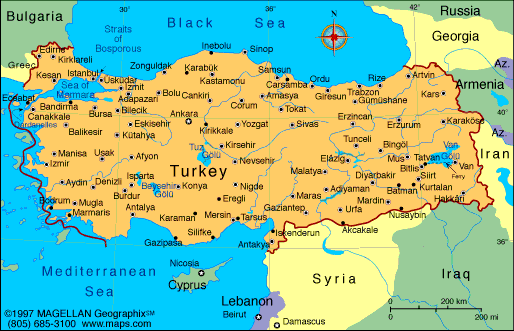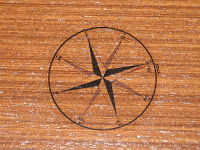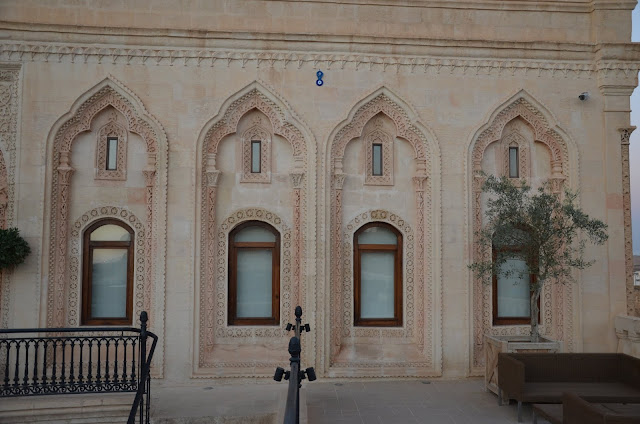Last weekend I went with ARIT to south east Turkey. We landed in Diyarbakir, which Google translate tells me means either Virgin Land or Realm of Copper, an interesting dichotomy. What I thought was most interesting about Diyarbakir was that the airport's code was DIY.

As you can see from the map we weren't too far from the Syrian boarder, especially on Saturday when we were in Mardin, but there aren't any Syrian cities close to there which are unstable and there are no refugees in any of the towns we visited, so we were 'completely' safe. That being said, I was still startled to see jet fighter planes parked at the airport and right after we landed I saw two take off and then heard four more after I was ushered inside. I didn't take any pictures, it happened too fast, but with Nick's help, I think it was an F16 that looked something like this: with one cone of bright blue flame coming out the back. It kind of set the tone and made me think about where I was.
 |
| Gideon's Compass Rose? |
When we checked into the hotel I found this sticker on the dresser. I hadn't seen one of these before, but I guess it makes sense. I wonder if it is left here by the Gideons? The hotel was very nice, but it was a generic American chain, which is great if you want a bathroom that works, but not all that interesting for a cultural experience. Dinner on the other hand was fantastic. We did have long to wait in the hotel (which I was grateful for, I have never understood, the sit in the hotel room for 90 minutes before going to dinner business).
We got back in the bus and went to Cercis Murat Konaği Geleneksel Mardin Mufaği
http://www.cercismurat.com/eng.htmlwhere we were ushered through an old seeming building up to the roof top terrace. We met our guide,
Ciğdem, while the restaurant was assembling tables. (Not just setting the tables, assembling them from legs and tops!) The cloths were beautiful and the mezes were different and very interesting. As you can see in this picture, they were served in large spoons on a specially designed platter which had divots for each spoon. Each one had a different sauce or paste in it, which you could eat directly or with bread. They were all delicious and different from anything I have had in Istanbul.
 |
| Meze spoons |

We were served two hot dolma mezes as well as well as salad, before we had the main course, which I think was lamb served with rice. It was all delicious and very rich. After we ate, they came around with intensely rose scented water to rinse our hands. This picture is of my roommate for the weekend, August, a very young grad student at Boazagi University who had a paper to write for Monday morning.
Even though it was very hot during the day, by the evening (9-10 pm) it had cooled down very pleasantly and I didn't mind that I was still wearing my school clothes and long pants outside for dinner. It was also incredibly dry (which of course is why it cooled down so remarkably) which made getting out of the shower quick and easy.
In the morning we started with a tour of Mardin's main street. Unfortunately it was under construction so the town was dusty and it was hard to walk. The bus gave up and dropped us off in the middle so we were on our own for the rest of the trip.
 |
| The edge of the road is placed first. |
Now when I say under construction, you shouldn't imagine heavy machinery. There were trucks to haul the materials, but the work was done by hand. The road bed had been prepared and was mostly smooth dirt where they were working. They a guy dug up some of the sand and placed the edge blocks of a reddish color. Then another guy used darker blocks to make semi circles of cobbles scalloping through the middle of the street. Each rock is placed by hand.
 |
| The cobbles are placed by hand |
I don't know how they are cut, but they are not uniform in size or shape, but they are very similar and all have a mostly flat side which will go up. Then sand is shoveled over the top and much of what we walked on was this sand, which, I assume, with time will work its way into the cracks between the cobbles to wedge them into place. It was really cool to be able to see the progress being made right then and there. We could see all steps of the process. On one end of the town they were still digging up the road to place the pipes underneath and at the other end of town the road was laid.
 |
| This is like a time lapse photo, except it was all happening at one time. |
While in Mardin we saw the Kasimiye Medresesi, which my guidebook says was built in 1469.
 |
| A dome of the Medresesi. |
 |
| These young entrepreneurs had been working hard to sell us bracelets until we went in. |
 |
| The courtyard of the medresesi |
 |
| Another dome, on a different medresesi. |
 |
| A bible in Aramaic. Assyrian Christians settled here in the 5th century. |
And then the Mardin Museum, which my guide book says is from the late 19th century.
 |
| Worshiping breasts for 8-10,000 years. |
 |
| These look like those cut outs you put your head in to instantly pretend to be a pirate, a caveman or an Indian princess. |
 |
| A diabolical cat with a big grin. |
After a visit to the Mardin Museum, we went to lunch:
 |
| Lunch was kofte from Kebapci Rido, which is grilled on long skewers and served with pide and salad. Unfortunately I only got 4 so I couldn't yedim yedim. |

After lunch we walked through the market area, which was off the main drag through winding back alleys full of all sorts of curiosities. We saw several butchers with meat hanging in the shop windows and a table of burned sheep heads. There was a guy carrying a door that I managed to get a picture of, as well as several metal goods shops. We did find a place that was selling the giant spoon meze set, but when am I ever going to make 12 different mezes to serve in it? It would have been kind of cool, though. I guess I could have filled half of them with bean dip and half with french onion dip. I did buy a hanging candle holder and a door bell with a dervish on it.
We were following
Ciğdem, but still half the group managed to get lost on the way to the Grand Mosque. According to the plaque on the mosque, it is one of the oldest mosques in Anatolia, dating back to the 11th century. It was perhaps plainer than other mosques I have been in and according to
Ciğdem, the most recent renovations have ruined the oldness of the place. In fact she said that many things in that area had been ruined by renovation. They might look nice, but the were no longer authentic and therefore not as cool. What surprised me inside the mosque was how wide but shallow it was. Most mosques I have been in have been almost square, but this must have been three times wider than it was deep.
 |
| The courtyard of the Ulu Cami, or grand mosque. |
 |
| A solitary supplicant in the Ulu Cami. |
 |
| A shop keeper waiting for your custom. |
 |
| Apparently Mardin is known for its blue almonds. They are candy coated, but not smooth like a Jordan almond, although similar. I bought some from this shop, but of course I didn't take a picture of the almonds themselves. |
 |
| Mardin from the road out of town. It is built on a hill so you can see all of the town at once. |
On our way to Midyat we stopped at a monetary, whose name I can't find written anywhere, but might be Rahiplerin Inzaivaya Cekildigi Manastirlar, if I haven't confused two places.
 |
| A nice and fairly accurate drawing of the monestary. |
 |
| A fountain with in the courtyard. |
Monastery's were supposed to be self sufficient for water, so they are built on a spring, which is tapped and flows through several pools, each of which has a meaning. I particularly liked this one.
 |
| Olives were everywhere. |
 |
| This was the ancient sun temple under the church which itself was 1500 years old. It is only so short because it has filled up with 1500 years worth of dust and dirt. |
 |
| Perhaps the most interesting feature of the sun temple is that its roof has no mortar, but is built with a keystone which has kept the roof from falling in for 15 centuries. |
 |
| This is the church over the sun temple. |
 |
| This is a pastoral country, even though it was the fertile crescent and the site of the beginning of agriculture. This is made even more interesting since I am currently reading Ismael by Daniel Quinn, which talks about this culture clash. |
 |
| Sunset on the way to Midyat. |
 |
| Midyat from the hotel balcony. |
 |
| Our hotel room, an interesting design, but a bit close for strangers. |
 |
| There was live music with dinner and some folks danced. Jo, from our group was enticed to join them. |
My roommate set her alarm for early to continue working on her paper. After asking what time it was, I looked out the window to see the moon setting over the town. I quickly forgave her for waking me up at 6am on a Sunday, got dressed and went out to take my favorite picture of the weekend.
 |
| Moon rise from almost the same spot as the previous picture. |
I just stayed up at that point and sat out on the roof watching the world sleep and/or wake up. Many folks were sleeping on their roofs, where it was quite comfortable both in temperature and humidity. The only danger was from neighborhood cats or tourists taking pictures.
 |
| Outside isn't a bad choice for place to sleep in this climate. |
 |
| The hotel balcony. |
 |
| A stray cat greets the sun rise. |
 |
| Peppers drying in the air destined to be dolma I believe. |
 |
| Taken from the hotel roof. |
 |
| Ciğdem, our guide explains something in a church. |
Since we arrived too late in the evening for the city tour of Midyat, we took the tour in the morning.
 |
| Ladies on their way somewhere |
 |
| This terraced house is the set for some famous Turkish soap opera, which I have never heard of, but the architecture is typical of the area and it is very nice. |
 |
| My Turkish word of the day: korkuluklara means both banister and scarecrow and means that thing you should be afraid of. |
 |
| This monkey was tied up above a silver shop in down town Midyat. I think it is my first Monkey in Turkey. |
 |
| The region is known for its silver working. |
 |
| A local resident keeps an eye on the street. |
 |
| Home to Seriac Christians |
 |
| A monastery courtyard |
 |
| A very old mosaic (the oldest in the middle east?) in the altar area of the church in Midyat |
 |
| A model of the monastery built out of match sticks |
 |
| I don't even need to speak Aramaic to know this church is old |
 |
| This coke machine, in the parking lot of the monastery actually produced cold cokes. |
 |
| We passed by Batman on our way to Hasankeyf and then through it on our way to the airport. I didn't see the caped crusader, but I did see plenty of caves. |
 |
| This is the old bridge across the Tigris at Hasankeyf, built in 1116 by |
 |
| Main street Hasankeyf, full of articles for sale as more and more tourists are visiting. |
 |
| Unfortunately the caves are closed and we couldn't climb up in them. |
You can see the citadel on top of the cliff as well as several other structures which have been built over the last 4000 years including temples, churches, mosques and dwellings. Apparently people lived in these caves until not too many years ago when the government kicked them out because they were afraid of terrorists. (or maybe they couldn't collect taxes on cave dwellers...) The caves were closed to visitors as well, not that we had time to explore them, but I am glad I got to see it since it is possible, even likely, that the whole place will be flooded when the Ilisu dam is finished. If you wan to join the resistance, check out
http://www.hasankeyfmatters.com/ a website that a fellow traveler of mine, John Crofoot maintains to promote and save Hasankeyf.
 |
| There are more caves on the other side of the river (view under the new bridge). |
 |
| This is the tomb of Zeynel Bey who died in 1473. |
We didn't have enough time at Hasankeyf, even though the caves were closed. As it was we barely made it back to Diyabakir in time for our flight. The flight was scheduled for 7pm, we arrived at the airport at 6:35, I was through security at 6:45 and on the plane at 6:50. I didn't need to check baggage or even get a boarding pass, so I was one of the first, but everyone from our group made it. Putting things on the line is a real signature of ARIT trips, but so far none of them have ended badly.
Unfortunately I was really not feeling well on the Sunday of this trip. I was having some stomach problems and I had a fever. I really wish I had been more aware of where I was and what I was seeing. I can think of so many other questions to ask now, that didn't occur to me at the time and clearly I didn't keep good track of what I was seeing while I was there. I will make an effort to be more prepared for the next trip in a couple of weeks to Gazientep.
